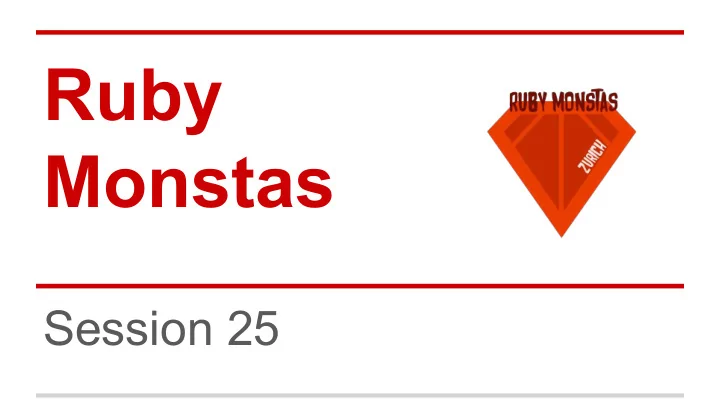

Ruby Monstas Session 25
Agenda Recap Layouts Exercises
Recap https://docs.google.com/presentation/d/1rxHrB4wLk7TMMMtIwC9azwNgnYQAFrae620IxjLHygI/edit#slide=id.ge8e058835_0_0
DIV element Text around<div> Outer DIV element <div>Inner DIV element</div> I will use the whole width of the site. </div>the DIV element This is a so-called block-level element. Because it breaks the flow of the elements into blocks. There are others: <h1>, <p>, <form> and so on
SPAN element This is a <span>S</span>pan elment This is a so-called inline element. Because it flows inline with all other elements. There are others: <a>, <i>, <b>, <strong> and so on
A simple layout example <!DOCTYPE HTML PUBLIC "- //W3C//DTD HTML 4.01//EN" "http://www.w3. org/TR/html4/strict.dtd"> <html> <body> <div class="header"> <h1>Header</h1> </div> <div class="sidebar"> <h2>Sidebar</h2> </div> <div class="content"> <h2>Content</h2> </div> <div class="footer"> <h1>Footer</h1> </div> </body> </html>
CSS .header, .footer { width: 720px; } .sidebar { float: left; height: 50%; width: 220px; } .content { float: left; height: 50%; width: 488px; } .footer { clear: both; }
HTML5: other elements An article with a title and text Embed audio & video <article> <h2>Article title</h2> <audio controls> <source src="foo.mp3" type="audio/mpeg"> <p>Article text</p> <source src="foo.ogg" type="audio/ogg"> </article> No support for audio </audio> <video controls> Main content <source src="foo.mp3" type="video/mpeg"> <source src="foo.ogg" type="video/ogg"> <main> No support for video <article> </video> ... </article> <article> ... </article> </main>
Layouts
Layouts What if we have a web app that always has the same structure with a certain part that is dynamic?
Layouts <!doctype html> < html lang="en"> < head > < title >Home page</ title > < link rel="stylesheet" href="/css/style.css"> </ head > < body > < header > < h1 >Welcome to our webpage!</ h1 > </ header > < nav > <!-- navigation --> </ nav > <main> < h3 >Welcome to our home page!</ h3 > We are Shirley, Ines and Peter! </main> < footer > <!-- footer --> </ footer > </ body > </ html >
Layouts <!doctype html> < html lang="en"> < head > < title >Home page</ title > < link rel="stylesheet" href="/css/style.css"> </ head > < body > < header > < h1 >Welcome to our webpage!</ h1 > </ header > < h3 >Welcome to our home page!</ h3 > < nav > <!-- navigation --> We are Shirley, Ines and Peter! </ nav > <main> <%= yield %> </main> < footer > <!-- footer --> </ footer > </ body > </ html >
Layouts <!doctype html> < html lang="en"> < head > < title >Home page</ title > < link rel="stylesheet" href=" /css/style.css"> </ head > < body > < header > < h1 >Welcome to our webpage!</ h1 > < h3 >Welcome to our home page!</ h3 > </ header > < nav > We are Shirley, Ines and Peter! <!-- navigation --> </ nav > <main> <%= yield %> </main> < footer > <!-- footer --> </ footer > </ body > </ html >
Layouts # app.rb get '/page' do erb :template1 end # views/layout.erb # views/template1.erb <!doctype html> < h3 >Welcome to our home page!</ h3 > < html lang="en"> [...] We are Shirley, Ines and Peter! < body > < header ></ header > < nav ></ nav > <main> <%= yield %> </main> < footer ></ footer > </ body > </ html >
Layouts: Conclusion The layout is the starting point for rendering a template. In it, you will find a yield block that actually renders the template you specify. The layout is therefore static and the template that is yielded is your dynamic part.
Your feedback, please? http://goo.gl/forms/rUrZqOPNq6 (Session 24)
Time to practice
Recommend
More recommend